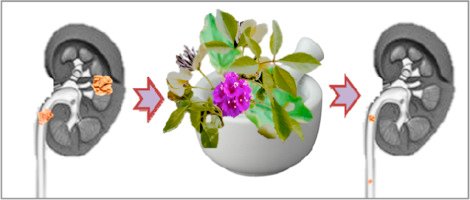In modern medical systems, several treatments are available to treat infectious and non-infectious diseases. However, some of these treatments have their own limitations and are unavailable to the majority of the world’s population due to accessibility and affordability reasons. For this reason, approximately 75% of people, mainly in low-economy countries, still rely on herbal remedies for their basic medical requirements (Barrett et al., 1999). In this regard, the demonstration of traditional medicines for diseases that are least likely to be life-threatening, such as urinary stones and hemorrhoids, should be considered.
Urinary stones (stones) are solid crystalline masses that can occur anywhere in the renal tract, and the process of formation of urinary stones or the appearance of stones anywhere in the urinary tract called lithiasis (Black and Hawks, 2005). The history of urinary tract stones dates back to the beginning of civilization. Paleopathological evidence supports its occurrence approximately 7000 years ago (Eknoyan, 2004). Urinary stone formation is a global health problem that can affect anyone at any age (Penescu et al., 2010). Although men are three times more likely to be affected than women, it is a rare disease in children (Thomas and Hall, 2005, Copelovitch, 2012). Approximately 0.1–0.4% of the population in the United States and Europe suffers from kidney stones each year (Robertson, 1993). It is estimated that approximately 2-5% of the population in Asia, 8-15% in Europe and North America, and 20% in Saudi Arabia will develop urinary stones during their lifetime (Robertson, 1993; Pak, 1998; Eknoyan, 2004 ) and the risk of recurrence is also high. It has been found that approximately 50% of patients experience stone recurrence within 10 years of initial onset (Thomas and Hall, 2005). The incidence of urinary stones is variable and usually varies by region. Areas with the highest incidence are Scandinavia and Mediterranean countries, the British Isles, northern Australia, central Europe, parts of the Malay Peninsula, China, Pakistan, and northern India. In contrast, parts of Latin America and Africa have the lowest incidence of kidney stones (Abbagani et al., 2010, Mikawlrawng et al., 2014).
Urinary stones can be classified according to their size, location, radiographic features, etiology of formation, composition, and risk of recurrence. However, among these, classification based on location in the body or chemical composition is more common (Türk et al., 2014). Nephrolithiasis is the presence of stones in the kidney. The term ureterolithiasis refers to stones located within the ureter. And cystolithiasis (or bladder stones) is used to refer to stones that form in or have entered the bladder (McNutt, 1893). Chemically, urinary stones are composed of inorganic and organic crystals fused with proteins. Commonly occurring urinary stones are mainly composed of calcium, uric acid, struvite, and ammonium acids (Moe, 2006). Approximately 60-85% of human stones are composed of calcium oxalate, calcium phosphate, or both.Uric acid stones account for approximately 10–20% of all urinary stones, with the remaining stones being rare stones composed mainly of struvite, carbonate apatite, and cystine (Park, 1998; Basavaraj et al., 2007; Becker, 2007) (Table 1). Among calcium-derived stones, calcium oxalate stones are more common than calcium phosphate. Hypercalciuria is the major risk factor in the pathophysiology of calcium nephrolithiasis. The second most common urinary stones are struvite stones, which are a mixture of magnesium, ammonium, and phosphate. These stones are also called “infection stones” because they may be associated with certain urinary tract infections. Uric acid stones are the third most common urinary stone and may be caused by hyperuricosuria, acidic urinary pH, or both. Cystine stones, which occur rarely, are generally formed from the amino acid cysteine and are caused by genetic defects in renal transport (Moe, 2006). Furthermore, melamine-related nephrolithiasis has recently been diagnosed in children ( Lam et al., 2009 , Fenner, 2011 ).
Urinary stones commonly form when the urine becomes saturated with salt or when the urine lacks the normal inhibitors of stone formation. Urolithiasis is influenced by several environmental nutritional factors, including decreased urine output and a diet rich in animal protein. Additionally, metabolic changes (hypercalciuria, hyperuricuria, etc.) and deficiencies in stone-inhibiting factors (citrate, magnesium, glycosaminoglycans) [GAG]) may also contribute to stone formation (Micali et al., 2006a). In the absence of a history of recurrence, urolithiasis is difficult to prevent because it often does not cause immediate symptoms and is often unrecognized until the condition is quite advanced. Small uroliths are more likely to pass with the urine. The observed spontaneous passage rate for stones less than 5 mm in diameter is mm and 5-10 mm are 68% and 47%, respectively (Xu et al., 2013).
Symptoms, signs, and treatments for urinary stones are described in several ancient medical texts of “Ayurveda,” “Chinese,” and “Greek traditional medicine” (López and Hoppe, 2010). Pain in the back or lower abdomen, blood in the urine, and pain when urinating are common symptoms of urinary stone disease. Other symptoms include nausea and vomiting, along with pain. A person with urinary stones experiences wave-like pain that starts in the abdomen and often spreads toward the groin, testicles, or vulva, increasing in intensity and eventually disappearing within 20 to 60 minutes. You must to do something before you go on. Minutes. This characteristic pain is called renal colic.
In most patients with urinary stones, the stones are too large or are trapped within the urinary system, so diet and stone removal therapy are ineffective. In such cases, patients should be treated with modern interventional procedures. However, most of these interventional procedures are not easy to evaluate and are poorly suited for patients with a high rate of urinary stone recurrence. As an alternative to this, ancient herbal medicines have been found to be effective, easily available, and inexpensive. Nevertheless, despite considerable historical records regarding the effectiveness and practice of these herbal medicines, widespread acceptance of these herbal medicines remains difficult. The reason behind this may be insufficient justification by scientific studies.

